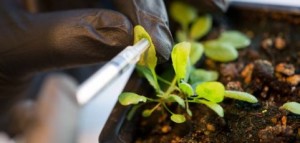The application of nanomaterials in agriculture aims in particular to reduce applications of plant protection products, minimize nutrient losses in fertilization, and increase yields through optimized nutrient management.
Nanotechnology devices and tools, like nanocapsules, nanoparticles and even viral capsids, are examples of uses for the detection and treatment of diseases, the enhancement of nutrients absorption by plants, the delivery of active ingredients to specific sites and water treatment processes. The use of target-specific nanoparticles can reduce the damage to non-target plant tissues and the amount of chemicals released into the environment. Nanotechnology derived devices are also explored in the field of plant breeding and genetic transformation.
Nanomaterials and nanostructures with unique chemical, physical, and mechanical properties like electrochemically active carbon nanotubes, nanofibers and fullerenes have been recently developed and applied for highly sensitive bio-chemical sensors. These nanosensors have also relevant implications for application in agriculture, in particular for soil analysis, easy bio-chemical sensing and control, water management and delivery, pesticide and nutrient delivery.
Nanotechnology is considered as one of the possible solutions to problems in food and agriculture. Just like biotechnology, issues of safety on health, biodiversity, and environment along with appropriate regulation are raised on nanotechnology.
Nanotechnology in agriculture has gained momentum in the last decade with an abundance of public funding, but the pace of development is modest, even though many disciplines come under the umbrella of agriculture. Nanotechnologic intervention in farming has bright prospects for improving the efficiency of nutrient use through nanoformulations of fertilizers, breaking yield barriers through bionanotechnology, surveillance and control of pests and diseases, understanding mechanisms of host-parasite interactions at the molecular level, development of new-generation pesticides and their carriers, preservation and packaging of food and food additives, strengthening of natural fibers, removal of contaminants from soil and water, improving the shelf-life of vegetables and flowers, clay-based nanoresources for precision water management, reclamation of salt-affected soils, and stabilization of erosion-prone surfaces, to name a few.
Nanotechnology will play a vital role in the development of the agricultural sector, as it is capable of being used in agricultural products that protect plants and monitor plant growth and detect diseases. Scientists have been working towards exploring new applications of nanotechnology in agriculture and the food industry – if these discoveries are applied sensibly, the environment, the agricultural sector and the food industry will indeed see tremendous changes for the better in the coming years.

